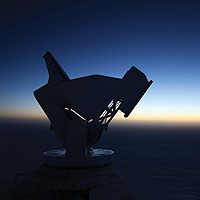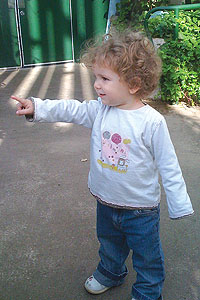Physical, social scientists share new research results at AAAS annual meeting
By Laurie Davisldavis@uchicago.edu
News Office
 Photo by Keith Vanderlinde The South Pole Telescope takes advantage of the clear, dry skies at the National Science Foundationís South Pole Station to study the cosmic background radiation, the afterglow of the big bang. University cosmologist John Carlstrom presented new findings at the AAAS annual meeting in Chicago earlier this week. |
|
 Professor Susan Goldin-Meadow and postdoctoral scholar Meredith Rowe presented their research on children and gestures at the AAAS annual meeting. They found that differences in gesture appeared early among children; moreover, differences in child gesture could be traced to differences in parent gesture. |
|
President Zimmer welcomed hundreds of researchers and science reporters to Chicago with his opening remarks for the 2009 Annual Meeting of the American Association for the Advancement of Science. The meeting kicked off Thursday, Feb. 12 at The Fairmont Chicago.
As a representative of the University at the AAAS meeting, Zimmer welcomed the symposium guests to the city with which the University shares its name, emphasizing a duality that exists to advance science while also making an impact on society’s progress.
This duality has “played an important part in our thinking about the future of the University—with a focus on science planning and education to ensure the University’s future contributions to science,” said Zimmer, “but also by focusing on how an urban university interacts with the city in which it resides and brings the results of its multifaceted research to bear on the city and the world.”
He pointed out that the approach to science in the public sphere also should reflect this duality. “The importance of basic research and the importance of the concrete applications of science to the problems we face are not in opposition; applications are, in part, an emergent property of the basic research enterprise,” said Zimmer. “As we address the wider public about the importance of science, it is both basic research and the capacity for improving the quality of human life that need to be emphasized as part of a single fabric.”
Zimmer also presented “Teaching Science as a Core Curriculum” at a session held on Monday, Feb. 16.
During the five-day symposium, scores of researchers from Argonne National Laboratory and Fermi National Accelerator Laboratory and the University presented new research in their fields, including John Cacioppo, the Tiffany and Margaret Blake Distinguished Service Professor in Psychology, and Jean Decety, the Irving B. Harris Professor in Psychology and Psychiatry.
Also among the presenters from the University were John Carlstrom, the S. Chandrasekhar Distinguished Service Professor in Astronomy & Astrophysics and Physics; Marie Coppola, Research Associate in Psychology; Susan Goldin-Meadow, the Beardsley Ruml Distinguished Service Professor in Psychology; and Jill Mateo, Assistant Professor in Comparative Human Development.
In “Social Emotion and the Brain,” Cacioppo and Decety discussed the affects of social isolation on behavior and brain function. Their pioneering research is the first to use fMRI scans to study the connections between perceived social isolation (or loneliness) and activity in the brain. Combining fMRI scans with data relevant to social behavior is part of an emerging field examining brain mechanisms.
Decety and Cacioppo discuss the new field of brain mechanisms in a paper in the current issue of Perspectives on Psychological Science. By studying brain mechanisms, researchers hope to gain new insights from examining mental activities surrounding consciousness, perception and thought through an understanding of how columns of neurons stacked next to each other form elementary circuits to function as a unit. More information on their research is at: http://news.uchicago.edu/news.php?asset_id=1547.
Carlstrom, who has been conducting research with a team of cosmologists with the South Pole Telescope, presented “The Cosmic Microwave Background: Progress and Prospects.”
During the next decade, a delicate measurement of primordial light could reveal convincing evidence for the popular cosmic inflation theory, which proposes that a random, microscopic density fluctuation in the fabric of space and time gave birth to the universe in a hot big bang approximately 13.7 billion years ago.
Carlstrom operates the SPT (South Pole Telescope) with a team of scientists from nine institutions in their search for evidence about the origins and evolution of the universe.
Their newest challenge is putting cosmic inflation theory to its most stringent observational test: detecting extremely weak gravity waves, which Einstein’s theory of general relativity predicts that cosmic inflation should produce.
More information about the South Pole scientists’ research is available at: http://news.uchicago.edu/news.php?asset_id=1550.
Coppola presented her findings in “Languages without Ancestors,” at the AAAS meeting. Her research shows that deaf children are able to develop a language-like gesture system by making up hand signs and using homemade systems to increase their communication as they grow, just as children with conventional spoken language.
Her work is the first to show that homesigning forms a foundation leading to more sophisticated and complicated communication. To read more about Coppola’s research, visit: http://news.uchicago.edu/news.php?asset_id=1544.
Goldin-Meadow and University Postdoctoral Scholar Meredith Rowe co-authored new research on children’s gesturing that was published in the AAAS journal Science. Their study is the first to connect gesture, vocabulary and school preparedness.
Goldin-Meadow presented the new work in a AAAS presentation titled “Embodied Language and Cognition: Brains, Mouths, and Hands.” The study results revealed that children who convey more meanings with gestures at age 14 months have much larger vocabularies at 54 months than children who convey fewer meanings and are accordingly better prepared for school.
The research showed that the differences particularly favored children from higher-income families with well-educated parents and may help explain the disadvantages some children. More information about the study is available at: http://news.uchicago.edu/news.php?asset_id=1543.
Mateo presented her new research findings on ground squirrels in “Sex and Smells: Kin Recognition, the Armpit Effect and Mate Choice.” Her work shows that animals can re-establish their use of smell to detect siblings, even following an interruption such as prolonged hibernation.
Smell is an important animal survival tool. Female ground squirrel sisters, for instance, bond in groups for protection and use smell to recognize each other. Animals also need to recognize siblings to avoid inbreeding, which would have a negative effect on their genetic fitness, said Mateo.
Mateo’s study on animals’ kin recognition is vital for planning conservation programs for endangered species. To read more about her research, visit: http://news.uchicago.edu/news.php?asset_id=1545.
![[Chronicle]](/images/sidebar_header_oct06.gif)